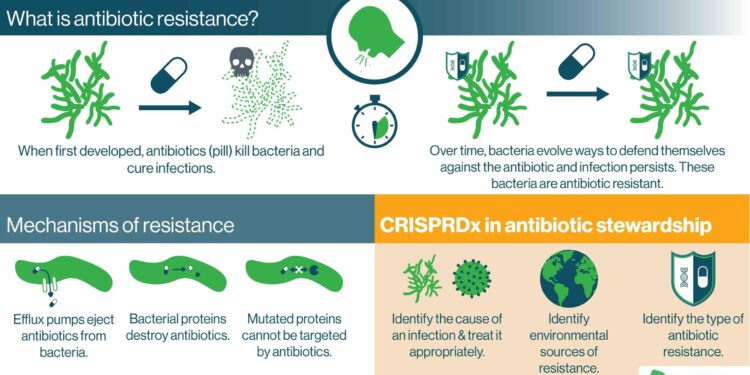Airborne Antibiotic Resistance Genes: A Growing Concern for Public Health
A recent study has unveiled a troubling reality regarding agricultural health and public safety: antibiotic resistance genes (ARGs) are widely present in the air around farming operations. This research, conducted by experts at the University of Minnesota’s Center for Infectious Disease Research and Policy (CIDRAP), raises significant concerns about the exposure risks faced by farmworkers and nearby residents. With antibiotic-resistant infections on the rise globally, these findings highlight an urgent need for effective strategies to curb the dissemination of these harmful genes in our environment. The study not only reveals hidden dangers lurking in seemingly safe areas but also emphasizes the necessity for heightened awareness and proactive measures to protect both agricultural laborers and surrounding communities.
Health Risks Associated with Airborne Antibiotic Resistance Genes
Recent investigations suggest that individuals living near agricultural fields face an increased risk of encountering ARGs in their environment. These genes, primarily spread through livestock farming practices, pose serious health threats to local communities as well as farm workers. The close proximity to livestock operations significantly contributes to airborne transmission of these potentially hazardous genes, complicating efforts aimed at managing health risks linked with antibiotic resistance.
The consequences of exposure to ARGs can be severe, leading to challenges such as:
- Increased treatment difficulties: Common infections may become harder to treat due to rising resistance levels.
- Escalating healthcare expenses: The financial burden on healthcare systems may grow as more complex treatments become necessary.
- Wider public health issues: Communities may face broader challenges related to disease management.
| Risk Factors | Potential Outcomes |
|---|---|
| Airing contaminated environments | An increase in local pathogen resistance levels |
| Nearing concentrated animal feeding operations (CAFOs) | A rise in hospitalization rates among residents |
Sources and Pathways of Airborne Antibiotic Resistance Genes on Farms
The alarming presence of ARGs within farm air highlights significant health risks not only for livestock but also for those working on farms. This research identifies key sources contributing to airborne pathogens, including:
- Dust Particles: Dust generated during farming activities can carry resistant bacteria into the atmosphere.
- Animal Excrement: Manure can release ARGs into the air under certain weather conditions.
- Aerosolized Irrigation Water: Contaminated water used during irrigation can aerosolize resistant bacteria into surrounding areas.
The pathways through which these genes circulate have been meticulously studied using a combination of air sampling techniques and genetic sequencing methods. Key pathways identified include:
- Evolving Wind Patterns: Strong winds have been shown capable of transporting bacteria over long distances, facilitating further spread of resistance traits.
- Agricultural Equipment Usage: Farming machinery can inadvertently distribute antibiotic-resistant microorganisms via contact with contaminated surfaces.
< li >< strong > Human Interactions: Daily interactions between farmworkers and animals heighten opportunities for spreading resistant gene variants .
Understanding these transmission routes is essential when developing effective intervention strategies aimed at reducing risks associated with antibiotic resistance within agricultural settings .
Approaches To Mitigate Health Risks Linked To Airborne Antibiotic Resistance Genes
The emergence of airborne antibiotic resistance genes presents considerable threats , particularly affecting vulnerable populations . In response , several approaches should be adopted aimed at minimizing exposure while protecting public health . First , enhancing monitoring systems< / strong > focused on air quality within agricultural regions will facilitate identification tracking levels associated with antibiotics resistant gene contamination . By employing advanced technologies such as genomic sequencing alongside traditional sampling methods , stakeholders gain insights necessary implement targeted interventions effectively .
< strong > Furthermore , stronger regulatory frameworks< / strong > governing antibiotics usage among livestock must be established encouraging responsible stewardship practices through educational initiatives designed reduce unnecessary applications agriculture settings . Collaboration between farmers , healthcare professionals environmental scientists remains crucial developing comprehensive policies limiting release resistant genetic material atmosphere Additionally investing resources towards< strong > community awareness campaigns< / strong >< will empower citizens understand implications surrounding this issue advocate better food production practices
Conclusion: Addressing a Critical Public Health Challenge
The revelations from this recent analysis concerning airborne antibiotic resistance genes underscore an urgent public health challenge that requires immediate action As agriculture evolves so too must our strategies monitor mitigate spread associated threats posed by exposure environments cannot afford overlook highlighting need comprehensive policies interventions designed safeguard both workers communities As discussions regarding stewardship continue this research serves reminder vulnerabilities inherent food production systems broader implications overall population wellbeing Policymakers farmers organizations must collaborate address growing threat ensure healthier future generations
The emergence of airborne antibiotic resistance genes presents considerable threats , particularly affecting vulnerable populations . In response , several approaches should be adopted aimed at minimizing exposure while protecting public health . First , enhancing monitoring systems< / strong > focused on air quality within agricultural regions will facilitate identification tracking levels associated with antibiotics resistant gene contamination . By employing advanced technologies such as genomic sequencing alongside traditional sampling methods , stakeholders gain insights necessary implement targeted interventions effectively .
< strong > Furthermore , stronger regulatory frameworks< / strong > governing antibiotics usage among livestock must be established encouraging responsible stewardship practices through educational initiatives designed reduce unnecessary applications agriculture settings . Collaboration between farmers , healthcare professionals environmental scientists remains crucial developing comprehensive policies limiting release resistant genetic material atmosphere Additionally investing resources towards< strong > community awareness campaigns< / strong >< will empower citizens understand implications surrounding this issue advocate better food production practices
Conclusion: Addressing a Critical Public Health Challenge
The revelations from this recent analysis concerning airborne antibiotic resistance genes underscore an urgent public health challenge that requires immediate action As agriculture evolves so too must our strategies monitor mitigate spread associated threats posed by exposure environments cannot afford overlook highlighting need comprehensive policies interventions designed safeguard both workers communities As discussions regarding stewardship continue this research serves reminder vulnerabilities inherent food production systems broader implications overall population wellbeing Policymakers farmers organizations must collaborate address growing threat ensure healthier future generations































